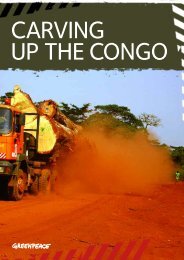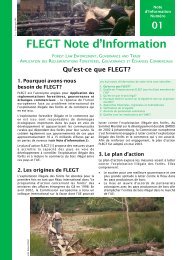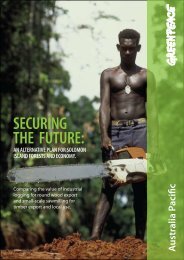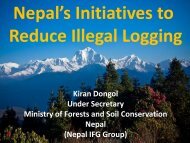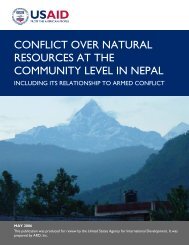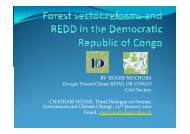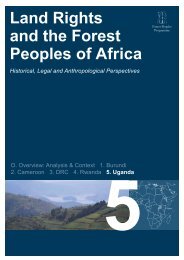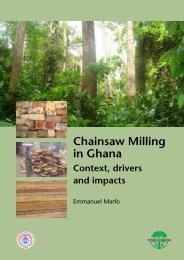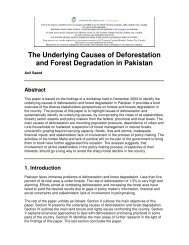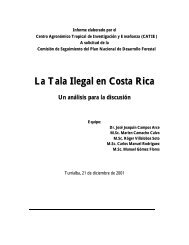Title Pakistan Forest Digest Issue 01- A4 - Pakistan Research Group
Title Pakistan Forest Digest Issue 01- A4 - Pakistan Research Group
Title Pakistan Forest Digest Issue 01- A4 - Pakistan Research Group
- No tags were found...
You also want an ePaper? Increase the reach of your titles
YUMPU automatically turns print PDFs into web optimized ePapers that Google loves.
SDPISustainable Development Policy Institutewith the guidance of their teachers.“The students love to indulge increative activities, which is goodfor them,” she added.The chief guests on the occasionwere MNA Anjum Aqeel and AirCommodore (r) Skindar Shah, whowere quite impressed by theperformance of students. They alsopraised the hard work anddedication of teachers.When parents entered eachclassroom the children greetedthem with a loud ‘good morning’and then introduced their work,which they had done in the class.“The confidance with which thechildren are presenting their workis remarkable,” one of the parentsremarked.The first class was play group,which was given the theme of seaanimals. The sea animals werehanged from the ceiling andcreated the right ambiance ofunderwater. Children had preparedstuffed animals and their faces onpaper plates and photo frames.Octopuses, fish, sea horses,dolphins, sharks and many otherswere painted on the walls. Thechildren in this class were 2 ½ to 3years old.The nursery class was given thetheme of farm animals. Horses,cows and goat were made withhand stuffed with wool. Thechildren were wearing headgearsand costumes of farm animals. Thevillage scene was also created inthe classroom.The KG class displayed petanimals and made various thingslike coin boxes, various animalfaces with used balls. A bigdollhouse was also placed in thecentre of the class that housedvarious pet animals. The KGstudents also presented world ofdinosaurs in which theyhad prepared variouskinds of dinosaurs.The Junior II-Cpresented insects andthe whole class wasfilled with creepy crawlers.Spiders, bee and ants wereeverywhere, which admired theparents.The junior I-C presentedcarnivore, omnivore and herbivoreanimals whereas junior I-Tpresented wildlife. The studentsgreeted the parents with the typical‘hoo haa’ as the jungle people doin the wild.The junior II-C presented birds inwhich students had preparedostriches and beautiful penguins.The Nursery-T presented gardenanimals in which butterflies,parrots and ladybirds were shown.World's forest cover shrinking: reportBusiness Recorder Islamabad, May 03, 2<strong>01</strong>0WASHINGTON: The world'sforest cover shrunk by 3.1 percentbetween 2000 and 2005, accordingto satellite observations detailed ina study. Hardest-hit were borealforests - the world's far northernsub-arctic forests - which accountfor about one-third of this loss,said the report, published in theApril 26-30 issue of the Annals ofthe National Academy of Sciences(PNAS).There are several causes of forestdestruction, including humancutting and natural phenomenasuch as fires ignited by lighting,the report said.Data on changes in the world'sforest cover are needed to estimatethe impact of carbon dioxideemissions, one of the maingreenhouse gases, and to setparameters for "global-scalebiogeochemical, hydrological,biodiversity and climate models,"read the report.The total forest loss between 2000and 2005 was estimated to be1,<strong>01</strong>1,000 square kilometers, theresearchers said. Boreal forests,which account for 26.7 percent ofthe world's forest cover, showedthe greatest shrinkage over thisperiod, losing 4 percent, or 34.7percent of the total forest lossduring the study period. Thereport's authors, from SouthDakota State University and theState University of New York,attributed two-thirds of the loss inboreal forest cover to fires.Tropical humid forests, whichcover 11.5 million squarekilometers and represent theworld's largest forested surface,lost 2.4 percent of their coverduring the research period, or 27percent of the overall loss.Tropical forests in dry regions -7.13 million square kilometers, or21.8 percent of the world's forestsurface - shrunk 2.9 percentbetween 2000 and 2005,representing 20.2 percent of totalforest loss.Geographically, North America,which had a 5.8 million squarekilometer forest cover in 2000,suffered the biggest loss during thestudy period, losing 5.1 percent or295,000 square kilometers,representing 29.2 percent of theoverall loss. – AFP<strong>Pakistan</strong> <strong>Forest</strong> <strong>Digest</strong> Vol. 1, No. 1, April – June, 2<strong>01</strong>0




